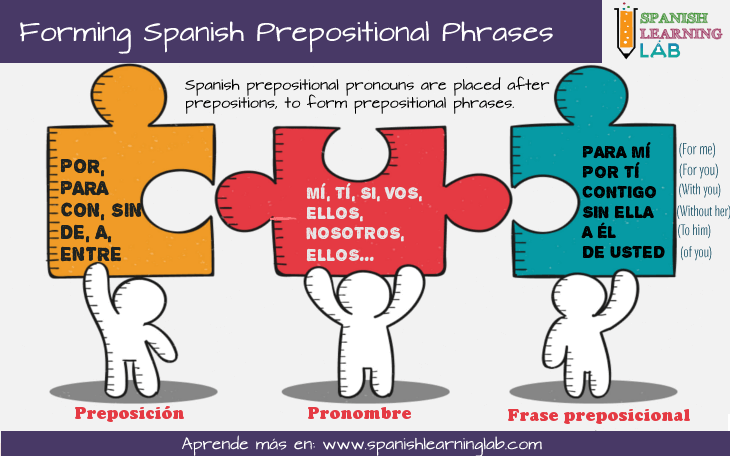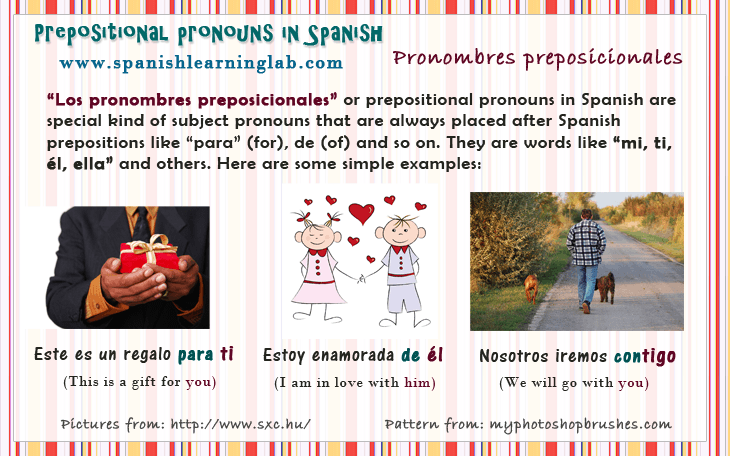What are Spanish prepositional pronouns? They are a very special type of pronouns that are placed after prepositions, just like the pronoun MI in the phrase “A MI”. These pronouns are very useful and common in everyday conversations to say simple stuff like “Esto es para ti” (this is for you) and to make more intermediate sentences such as “Me gustaría hablar contigo”. This lesson will explain how these pronouns work and the easiest way to use them in real conversations. More importantly, we will focus on practicing Spanish prepositional pronouns. Let’s start…
What are Spanish prepositional pronouns?
Spanish prepositional pronouns fall into the category of “Pronombres tónicos”. As mentioned before, these pronouns are related to subject pronouns such as “Yo, Tú, Él…”, but this specific group will be used with or after prepositions like CON (with), SIN (without), DE (of/from). The first thing you need to know to master prepositional pronouns is recognizing some common prepositions in Spanish. For instance, prepositions of place (las preposiciones de lugar) are used to indicate the location of objects. Most of the time, prepositional pronouns will be used after the prepositions DE (of/from), CON (with) and SIN (without). They can also be used with POR (for/because of) and PARA (for), though this may be a little confusing sometimes. As a result of this combination, we will form prepositional phrases like the ones shown in the picture below:

It is important to find the pronoun that corresponds to the noun(s), people or things, we are referring to. In a certain way, Spanish prepositional pronouns will correspond to direct object pronouns in English, just like YOU in the sentence “This is for you” (Esto es para ti). TI would be the proper match for YOU in Spanish for this scenario, but if we were using YOU to refer to several people then USTEDES would be a better match as in “Esto es para ustedes”.
Spanish prepositional pronouns list
| Spanish pronoun | English pronoun |
|---|---|
| Mí | Me |
| Ti/vos | You |
| Usted(formal) | You |
| Él, ella, ello, si | Her, him |
| Nosotros, nosotras | Us |
| Vosotros, vosotras | You |
| Ustedes | You |
| Ellos, ellas, si | Them |
Using Spanish prepositional pronouns in sentences
In order to make sentences with Spanish prepositional pronouns, we need to find a preposition and then the right pronoun for the object that we want to refer to. Imagine you want to say something like “Life without you”. Since “LIFE” is an abstract noun, we would translate it into “LA VIDA”, the word “WITHOUT” would be SIN and “YOU” would be TI. In this specific example, YOU could also be “Usted, Ustedes, Vos, Vosotros, Vosotros” so it is all up to the formality of the conversation and the number of people we are addressing.

Spelling changes in prepositional pronouns and special cases
- When TI is used after the preposition CON, we will not say CON TI but CONTIGO.
- In situations in which MI is used after CON, the prepositional phrase will be spelled as CONMIGO.
- When SI is used after the preposition CON, the spelling will change to CONSIGO.
- It is incorrect to use the pronoun “mí, ti, vos” after DE when we mean possession, as in “Esto es de mí”. Instead, we should say “Esto es mío”, using a possesive pronoun. However, if you mean that something comes FROM (DE) you to someone else, then it is fine to use DE + a preprositional pronoun as in “El regalo es de mi para ti” (The gift is from me for you)
- Last, we do not use prepositional pronouns after ENTRE (between), but subject pronouns like “Yo, tú…”. It would be incorrect to say “Es un problema entre ti y mí”. The right way would be “Es un problema entre tú y yo”. Always try to mention the other person before saying YO in Spanish because that is a sign of politeness.
Sentences using Spanish prepositional pronouns in interesting situations
|
¿Crees que esto es para mí?
Do you think this is for me?
|
|
Tú siempre estás conmigo.
You are always with me
|
|
No te preocupes. Lo hice por ti.
Don´t worry! I did it for you.
|
|
Adivina qué? Tengo algo para vos.
Guess what. I have something for you.
|
|
Trabajaré con usted.
I will work with you
|
|
El perro es de él.
The dog is his
|
|
La casa es de ella.
The house is hers
|
|
No puedes comenzar sin nosotros.
You can´t begin without us
|
|
¿Está Carlos con vosotros?
Is Carlos with you?
|
|
El negocio es entre nosotros y ellas.
The business is between us and them
|
We are almost over with the lesson. Hopefully the examples helped you understand how to use these pronouns more easily. Before you go, practice Spanish prepositional pronouns with another interactive quiz. ¡Hasta pronto!
